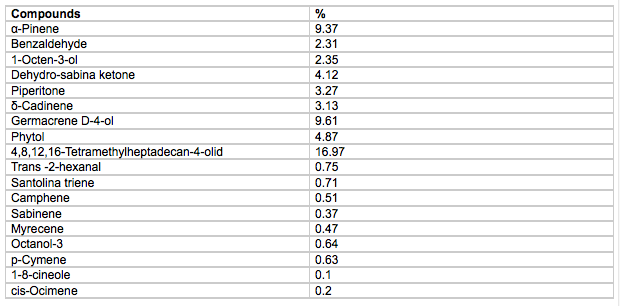Horehound
Background & General Info
Horehound, or Marrubium vulgare, is a flowering perennial indigenously found in abundance in Europe, Western Asia, and North Africa and recently has been widely naturalized and cultivated globally for flavoring and medicinal purposes. [1]

Horehound - Botany
Horehound can be upright or creeping and distinctly has a pungent or aromatic odor in almost all of its parts. Its oval to circular, grayish-green leaves are arranged oppositely on the erect stem and have toothed or jagged edges. The leaves’ undersides are carpeted with white woolly hairs, while the upper surface seems densely wrinkled or puckered. From April to September, tiny white flowers emerge in dense round clusters from where the leaf attaches to the stem, with each flower individually producing four dark brown nutlets that hold a seed. [2]
Horehound - History & Traditional Use
Horehound is considered a traditional remedy for inflammatory-related symptoms, including cold, fever, and sore throat, and its use as a medicinal herb even goes back to the time of ancient Egypt. [1][3] In folk medicinal systems of many countries such as Mexico, it is also regarded as treatment of diabetes. [4] In Algerian folk medicine, horehound is employed to cure diabetes, rheumatism, colds, respiratory discomfort, and conditions related to the digestive tract such as diarrhea. [1]
Horehound - Herbal Uses
Due to their high level of antioxidant action, water extracts from horehound leaves have been associated with beneficial effects, most especially as traditionally used treatment of colds, fever, sore throat, and respiratory ailments, including asthma and cough. [3]

Horehound - Constituents / Active Components
Horehound contains a number of siterpenoids, including marrubiin and marrubenol, which possibly explains its therapeutic effect against respiratory problems, and several anti-inflammatory phenylpropanoid derivatives. [3] Analysis by GC and GC/MS of horehound essential oil by Weel et al. (1999) revealed a total of 47 components, with (Z)-β-farnesene, β-caryophyllene, (E)-hex-2-enal, α-humulene, and germacrene D having been identified as the major ones. [5] Hamdaoui et al. (2013) similarly investigated the composition of hydrodistilled essential oil derived from dried aerial parts of Marrubium vulgare using GC and GC/MS and identified 35 components, which compose 74.6 % of the entire oil. A high amount of sesquiterpenes, accounting to 50.5 %, was found in horehound essential oil, and β-bisabolene (28.3 %), β- caryophyllene (7.8 %), (E)-β-farnesene (7.4 %), and 1,8-cineole (4.8 %) appeared to be the chief constituents. [6]
The chemical composition of horehound essential oil and the percentage of its major components, based on the results of Abadi and Hassani’s study, is presented in the table below. [1]

Horehound - Medicinal / Scientific Research
Cardiovascular:
Horehound has been documented to significantly lower systolic blood pressure in spontaneously hypertensive rats, most likely because of its vasorelaxant and anti-hypertrophic properties, and to also relax the aorta (the main artery). The plant’s other cardiovascular effects reported in literature include potentiation of acetylcholine-induced relaxation of the mesenteric artery, improvement of diminished endothelial function in spontaneously hypertensive rats, and an anti-hypertrophic activity in the aorta. Although the mechanism of horehound’s cardiovascular action is still not entirely understood, its various constituents appear to be responsible for the vasculoprotective effects. For instance, its diterpene marrubenol has been demonstrated to potently block L-type calcium channels, leading to the inhibition of contraction in vascular smooth muscle cells. Aside from marrubenol, marrubiin isolated from horehound has been found to suppress contractions induced by potassium chloride in rat aorta, whereas its phenylpropanoids can also impede lipoprotein-induced secretion of endothelin-1, a powerful vasoconstrictor. [7]
Antioxidant:
Findings of a 2016 Algerian study pointed out a potent antioxidant activity for various horehound extracts. However, the extracts’ free radical-scavenging activity remarkably differed depending on sampling location and type of organic solvent used, with methanol, chloroform, and ethyl acetate extracts displaying the highest percentages of inhibition (from 54.8 to 98.8% at 1000 μg/mL). Such antioxidant activity of horehound can be attributed to its flavonoid content, with flavonoid concentrations ranging from 40.7 to 160 mg gallic acid equivalents/g and from 27.4 and 66.3 mg catechin equivalents/g. [8] Weel et al. (1999) also demonstrated antioxidant activity of extracts from horehound leaves, which was comparable to that of sage extracts. Acetone extracts of both plants proved to manifest better antioxidant activity than deodorized acetone extracts. [5]
Anticancer:
Yamaguchi et al. (2006) reported the anti-proliferative activity of extracts of horehound leaves against human colorectal cancer cells, which suppressed the growth of cancer cells and induced apoptosis. Furthermore, horehound extract upregulated nonsteroidal anti-inflammatory drug-activated gene (NAG-1) by trans-activating the NAG-1 promoter. This gene, identified in human colorectal cancer HCT-116 cells, has been revealed to stimulate apoptosis, and its expression is augmented by NSAIDs in colorectal cancer cells. [3]
Paunovic et al. (2016) on the other hand determined the anticancer effects of horehound ethanol extract against melanoma and glioma cells. A dose-dependent decrease in the viability of melanoma and glioma cells was observed following provision of horehound ethanol extract, but not peripheral blood mononuclear cells. The extract halted the cell cycle in S+G2/M phase of cancer cells; such action was linked to an activation of MAP kinase p38 and an upregulation of antiproliferative genes p53, p21, and p27. Additionally, horehound ethanol extract exerted several effects that are in general deterrent to the growth and development of cancer cells, including induction of mitochondrial depolarization, activation of caspases-9 and -3, Parp cleavage, phosphatidylserine exposure, initiation of DNA fragmentation, stimulation of the expression of autophagy-related genes Atg5, Atg7, Atg12, Beclin-1, Gabarab, and Sqstm1, and LC3-I conversion to the autophagosome-associated LC3-II. [9]
Anti-inflammatory:
Stulzer et al. (2006) illustrated the ability of marrubiin, a chief constituent of horehound, to counter the development of edema during an inflammatory response. Overall, the results from this study indicated that systemic administration of marrubiin results in a nonspecific inhibition of microvascular extravasation. With analysis carried out in a model of microvascular leakage in mouse ears, this compound displayed notable, dose-related “antiedematogenic” activity. In this study, the maximal inhibition of histamine, carrageenan, and prostaglandin E2 was 73.7%, 63.0%, and less than 50%, respectively. At a dose of 100 mg/kg, marrubiin significantly prevented allergic edema elicited by ovalbumin in actively sensitized animals, with a maximal inhibition of around 67.6%. [10]
Antidiabetic:
A 2015 study published in the International Journal of Diabetes Mellitus presented data suggesting the antihyperglycemic and antidyslipidemic effect of horehound methanol extract, with the extract’s protective potential being attributable in part to its antioxidant activity. The methanol extract, which was derived from the aerial parts of horehound, was orally administered to streptozotocin-induced diabetic rats daily for 28 days at a dose of 500 mg/kg/day. This resulted in a significant reduction of blood glucose levels of diabetic rats from the second week onward and an elevation of plasma insulin and tissue glycogen contents. There was also a noteworthy drop in levels of plasma total cholesterol, triglycerides, and low-density lipoprotein-cholesterol but an increase in high-density lipoprotein-cholesterol (the “good” heart-protective cholesterol), signifying an antidyslipidemic effect. [4]
Hepatoprotective:
A 2016 Tunisian study demonstrated the ability of horehound to protect the liver against toxicity from cyclophosphamide (a chemotherapy drug) in Wistar rats. In this study, injection of cyclophosphamide at a dose of 150 mg/kg resulted in a reduction of enzymatic defense system against oxidative stress, altered the liver biomarkers, and augmented lipid peroxidation, suggesting liver toxicity. 30-Day oral administration of horehound aqueous extract at a concentration of 500 mg of dry leaves/kg/day led to much less change in activities of all biological parameters in treated rats, including alanine amino transferase (ALAT), aspartate amino transferase (ASAT), lactate dehydrogenase (LDH), alkaline phosphatase (ALP), lipid peroxidation level, superoxide dismutase, catalase (CAT), and glutathione peroxidase (GPx), suggesting diminution of cyclophosphamide-induced liver damage. [11]
A 2010 study by Ahmed et al. identified a new terpenoid called p-menthane-5,6-dihydroxy-3-carboxylic acid from the whole horehound plant. It has been found out that this terpenoid significantly counters liver toxicity by diminishing any increase in levels of serum enzymes, such as serum glutamate oxaloacetate transaminase (SGOT), serum glutamate pyruvate oxaloacetate transaminase (SGPT), and ALP, which were reduced by 40.16%, 35.06%, and 30.51%, respectively. [12]
Pain Relief:
Horehound has been scientifically evidenced in diverse experimental models to display antispasmodic effect and to block the detection of pain sensation. Particularly, its main component, marrubiin, has been proven to exhibit potent and dose-dependent antinociceptive activity. In fact, according to De Jesus et al. (2000), this compound is more potent than some popular analgesic drugs, does not interact with opioid systems, and produces antinociceptive effect that is not reversed by naloxone (an opioid antagonist), as analyzed against the writhing test. [13]
Horehound - Contraindications, Interactions, And Safety
The use of horehound is, in general, considered safe, with no contraindications or interactions with drug having been concretely identified or documented. Note that horehound has abortifacient (abortion-inducing) effects and stimulates menstrual flow and information on its efficacy and safety during pregnancy and lactation is scarce, so pregnant women must never use it. [14]
References:
[1] A. Abadi and A. Hassani, "Chemical composition of Marrubium vulgare L. essential oil from Algeria," International Letters of Chemistry, Physics and Astronomy, vol. 8, no. 3, p. 210–214, 2013. https://www.scipress.com/ILCPA.13.210
[2] A Northern Arizona Homeowner’s Guide to Identifying and Managing Horehound. The University of Arizona. https://extension.arizona.edu/sites/extension.arizona.edu/files/resources/horehound.pdf
[3] K. Yamaguchi, J. L. Liggett, N.-c. Kim and S. J. Baek, "Anti-proliferative effect of horehound leaf and wild cherry bark extracts on human colorectal cancer cells," Oncology Reports, vol. 15, no. 1, p. 275–281, 2006. https://www.ncbi.nlm.nih.gov/pubmed/16328068
[4] A. A. Elberry, F. M. Harraz, S. A. Ghareib, S. A. Gabr, A. A. Nagy and E. Abdel-Sattar, "Methanolic extract of Marrubium vulgare ameliorates hyperglycemia and dyslipidemia in streptozotocin-induced diabetic rats," International Journal of Diabetes Mellitus, vol. 3, no. 1, p. 37–44, 2015. https://www.sciencedirect.com/science/article/pii/S1877593411000051
[5] K. G. Weel, P. R. Venskutonis, A. Pukalskas, D. Gruzdiene and J. P. Linssen, "Antioxidant activity of horehound (Marrubium vulgare L.) grown in Lithuania," European Journal of Lipid Science and Technology, vol. 101, no. 10, p. 395–400, 1999. https://onlinelibrary.wiley.com/doi/10.1002/(SICI)1521-4133(199910)101:10%3C395::AID-LIPI395%3E3.0.CO;2-L/abstract
[6] B. Hamdaoui, W. A. Wannes, M. Marrakchi, N. B. Brahim and B. Marzouk, "Essential oil composition of two Tunisian horehound species: Marrubium vulgare L. and Marrubium aschersonii Magnus," Journal of Essential Oil Bearing Plants, vol. 16, no. 5, p. 608–612, 2013. https://www.tandfonline.com/doi/abs/10.1080/0972060X.2013.854492
[7] M. Akhtar Anwar, S. S. Al Disi and A. H. Eid, "Anti-hypertensive herbs and their mechanisms of action: Part II," Frontiers in Pharmacology, vol. 7, p. 50, 2016. https://www.ncbi.nlm.nih.gov/pmc/articles/PMC4782109/
[8] K. Bouterfas, Z. Mehdadi, M. Elaoufi, A. Latreche and W. Benchiha, "Antioxidant activity and total phenolic and flavonoids content variations of leaves extracts of white Horehound (Marrubium vulgare Linné) from three geographical origins," Annales Pharmaceutiques Francaises, vol. 74, no. 6, p. 453–462, 2016. https://www.ncbi.nlm.nih.gov/pubmed/27553439
[9] V. Paunovic, M. Kosic, S. Djordjevic, et al., "Marrubium vulgare ethanolic extract induces proliferation block, apoptosis, and cytoprotective autophagy in cancer cells in vitro," Cellular and Molecular Biology (Noisy-le-grand), vol. 62, no. 11, p. 108–114, 2016. https://www.ncbi.nlm.nih.gov/pubmed/27755961
[10] H. Stulzer, M. Tagliari, J. Zampirolo, et al., "Antioedematogenic effect of marrubiin obtained from Marrubium vulgare," Journal of Ethnopharmacology, vol. 108, no. 3, p. 379–384, 2006. https://www.ncbi.nlm.nih.gov/pubmed/16846706
[11] A. Ettaya, S. Dhibi, N. Samout, A. Elfeki and N. Hfaiedh, "Hepatoprotective activity of white horehound (Marrubium vulgare) extract against cyclophosphamide toxicity in male rats," Canadian Journal of Physiology and Pharmacology, vol. 94, no. 4, p. 441–447, 2016. https://www.ncbi.nlm.nih.gov/pubmed/26886858
[12] B. Ahmed, M. Masoodi, A. Siddique and S. Khan, "A new monoterpene acid from Marrubium vulgare with potential antihepatotoxic activity," Natural Product Research, vol. 24, no. 18, p. 1671–1680, 2010. https://www.ncbi.nlm.nih.gov/pubmed/20628963
[13] R. De Jesus, V. Cechinel-Filho, A. Oliveira and V. Schlemper, "Analysis of the antinociceptive properties of marrubiin isolated from Marrubium vulgare," Phytomedicine, vol. 7, no. 2, p. 111–115, 2000. https://www.ncbi.nlm.nih.gov/pubmed/10839213
[14] M. Kchouk, et al., "On the abortive properties of white horehound (Marrubium vulgare L.)," Archives de l'Institut Pasteur de Tunis, vol. 40, p. 129–132, 1963. https://www.ncbi.nlm.nih.gov/labs/articles/14085249/
Article researched and created by Dan Ablir for herbshealthhappiness.com.
© herbshealthhappiness.com


1. Famous Chef Sheds 60lbs Researching New Paleo Recipes: Get The Cookbook FREE Here
2. #1 muscle that eliminates joint and back pain, anxiety and looking fat
3. Drink THIS first thing in the morning (3 major benefits)
4. [PROOF] Reverse Diabetes with a "Pancreas Jumpstart"
5. Why Some People LOOK Fat that Aren't
6. Amazing Secret Techniques To Protect Your Home From Thieves, Looters And Thugs
7. The #1 WORST food that CAUSES Faster Aging (beware -- Are you eating this?)
![]()
![]()
![]()
If you enjoyed this page:






























